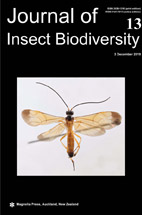Abstract
The geographic distribution of Gomphurus ozarkensis (Westfall, 1975), a species described to science only four decades ago, is confined to a four-state area in the central United States: southeastern Kansas, eastern Oklahoma, western and northern Arkansas, and southern Missouri. Its small range has led some to classify it a species of conservation concern. We examined geographic variation in the species, which despite its small range exists in three distinct subpopulations: one in the Ouachita Mountains of western Arkansas and southeastern Oklahoma; one on the Ozark Plateau of northeastern Oklahoma, southeastern-most Kansas, southern Missouri, and northern Arkansas; and one in the Osage/Flint hills of southeastern Kansas and northeastern Oklahoma. Clinal variation is evident in the extent of yellow on the terminal abdominal segments and the extent to which certain thoracic stripes are fused. A population in a separate watershed basin in the southern Osage Hills of Oklahoma is taxonomically distinct, with some phenotypic characters tending toward G. externus (Hagen, 1858). We describe this population as a new subspecies of G. ozarkensis.
References
Battin T. 1992. Geographic variation analysis among populations: the case of Platycnemis pennipes (Pallas, 1771) (Insecta: Odonata: Zygoptera) in the Aegean. Journal of Biogeography 19: 391–400.
https://doi.org/10.2307/2845567
Bick G. H. 1983. Odonata at risk in conterminous United States and Canada. Odonatologica 12: 209–226.
Bick G. H. 2003. At-risk Odonata of [the] conterminous United States. Bulletin of American Odonatology 7: 41–56.
Braby M. F., Eastwood R. & Murray N. 2012. The subspecies concept in butterflies: Has its application in taxonomy and conservation biology outlived its usefulness? Biological Journal of the Linnean Society 106: 699–716.
https://doi.org/10.1111/j.1095-8312.2012.01909.x
Catling P. M. & Hughes M. 2008. Variation in Canadian Gomphus fraternus (Odonata: Gomphidae) in relation to the recognition of subspecies manitobanus. Canadian Entomologist 140: 327–337.
https://doi.org/10.4039/n07-036
Chown S. L. & Gaston K. J. 2010. Body size variation in insects: A macroecological perspective. Biological Reviews 85: 139–169.
https://doi.org/10.1111/j.1469-185X.2009.00097.x
Donnelly T. W. 1987. Structural variation of Ophiogomphus mainensis: Description of a new subspecies and relationship to sibling species (Odonata: Gomphidae). Proceedings of the Entomological Society of Washington 89: 205–214.
Gillham N. W. 1956. Geographic variation and the subspecies concept in butterflies. Systematic Zoology 5: 110–120.
https://doi.org/10.2307/2411573
Hawkins B. A. & DeVries P. J. 1996. Altitudinal gradients in the body sizes of Costa Rican butterflies. Acta Oecologica 173: 185–194.
Hubbell T. H. 1956. Some aspects of geographic variation in insects. Annual Review of Entomology 1: 71–88.
https://doi.org/10.1146/annurev.en.01.010156.000443
Kenner R. D. 2000. Somatochlora kennedy (Odonata: Corduliidae): A new species for British Columbia, with notes on geographic variation in size and wing venation. Journal of the Entomological Society of British Columbia 97: 47–50.
Kosterin O. E. 2014. Notes on infraspecific variation of some Gomphidae (Odonata) species in Cambodia. International Dragonfly Fund Report 68: 1–16.
Kruschke J. K. 2013. Bayesian estimation supersedes the t test. Journal of Experimental Psychology: General 142: 573–603.
https://doi.org/10.1037/a0029146
McCauley S. J. 2010. Body size and social dominance influence breeding dispersal in male Pachydiplax longipennis (Odonata). Ecological Entomology 35: 377–385.
https://doi.org/10.1111/j.1365-2311.2010.01191.x
Páll-Gergely B., Asami T. & Sólymos P. 2019. Subspecies description rates are higher in morphologically complex land snails. Zoological Scripta 48:in press.
https://doi.org/10.1111/zsc.12319
Patten M. A. 2015. Subspecies and the philosophy of science. Auk: Ornithological Advances 132: 481–485.
https://doi.org/10.1642/AUK-15-1.1
Patten M. A. & Remsen J. V., Jr. 2017. Complementary roles of phenotype and genotype in subspecies delimitation. Journal of Heredity 108: 462–464.
https://doi.org/10.1093/jhered/esx013
Patten M. A. & Smith-Patten B. D. 2013. Odonata species of special concern for Oklahoma, USA. International Journal of Odonatology 16: 327–350.
https://doi.org/10.1080/13887890.2013.868328
Patten M. A. & Unitt P. 2002. Diagnosability versus mean differences of Sage Sparrow subspecies. Auk 119: 26–35.
https://doi.org/10.2307/4090009
Pérez-Valencia L. I. & Moya-Raygoza G. 2015. Body size variation of Diaphorina citri (Hemiptera: Psyllidae) through an elevation gradient. Annals of the Entomological Society of America 108: 800–806.
https://doi.org/10.1093/aesa/sav072
Phillimore A. B., Orme D. L., Davies R. G., Hadfield J. D., Reed W. J., Gaston K. J., Freckleton R. P. & Owens I. P. F. 2007. Biogeographical basis of recent phenotypic divergence among birds: A global study of subspecies richness. Evolution 61: 942–957.
https://doi.org/10.1111/j.1558-5646.2007.00068.x
Plummer M. 2003. JAGS: A program for analysis of Bayesian graphical models using Gibbs sampling. Proceedings of the 3rd International Workshop on Distributed Statistical Computing.
Rapoport E. H. 1969. Gloger’s rule and pigmentation of Collembola. Evolution 23: 622–626.
https://doi.org/10.1111/j.1558-5646.1969.tb03545.x
Sagedhi S., Adriaens D. & Dumont H. 2009. Geometric morphometric analysis of wing shape variation in ten European populations of Calopteryx splendens (Harris, 1782) (Zygoptera: Odonata). Odonatologica 38: 343–360.
Sawilowsky S. S. 2009. New effect size rules of thumb. Journal of Modern Applied Statistical Methods 8: 597–599.
https://doi.org/10.22237/jmasm/1257035100
Shelomi M. 2012. Where are we now? Bergmann’s rule sensu lato in insects. American Naturalist 180: 511–519.
https://doi.org/10.1086/667595
Skalski J. R., Townsend R. L., McDonald L. L., Kern J. W. & Millspaugh J. J. 2008. Type I errors linked to faulty statistical analyses of endangered subspecies classifications. Journal of Agricultural, Biological, and Environmental Statistics 13: 199–220.
https://doi.org/10.1198/108571108X310771
Smith-Patten B. D. & Patten M. A. 2017. Update on the Oklahoma Odonata Project: Anisopterans. Argia 29(1): 1–10.
Stewart S. S. & Vodopich D. S. 2018. Environmental effects on wing shape and wing size of Argia sedula (Odonata: Coenagrionidae). International Journal of Odonatology 21: 189–203.
https://doi.org/10.1080/13887890.2018.1523752
Stewart W. E. 1982. An analysis of geographic variation of the adults of the Australian genus Diphlebia Selys (Odonata: Amphipterygidae). Australian Journal of Zoology 30: 433–460.
https://doi.org/10.1071/ZO9820435
Susanke G. R. & Harp G. L. 1991. Selected biological aspects of Gomphurus ozarkensis (Westfall) (Anisoptera: Gomphidae). Advances in Odonatology 5: 143–151.
Venables W. N. & Ripley B. D. 2002. Modern Applied Statistics with S, 4th edn. Springer, New York.
https://doi.org/10.1007/978-0-387-21706-2
Westfall M. J., Jr. 1975. A new species of Gomphus from Arkansas (Odonata: Gomphidae). Florida Entomologist 58: 92–95.
https://doi.org/10.2307/3493387

